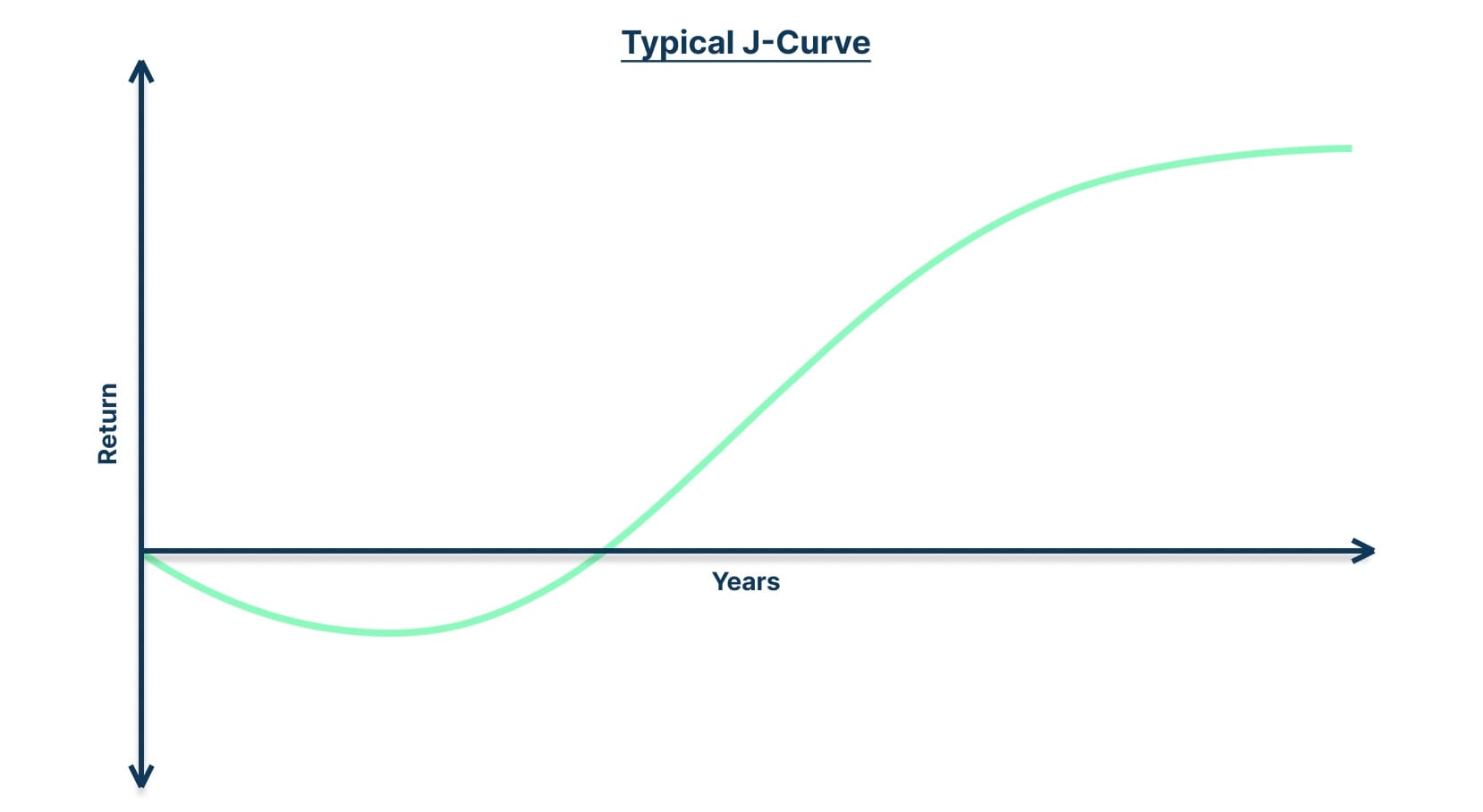What Is The J-Curve In Private Equity?

Have you ever wondered why some private equity funds initially show negative returns before eventually generating significant profits?
How does this phenomenon impact investor returns, and what factors contribute to this trend? Explore the concept of the J-Curve in private equity and uncover the secrets behind its unique shape.
Key Takeaways:
- The J-Curve in private equity represents the trend of initial negative returns followed by a gradual recovery in investor profits.
- This phenomenon is influenced by factors such as investment costs, management fees, underperforming portfolios, and the time it takes for investments to mature.
- Understanding the J-Curve is essential for investors to set realistic expectations and align their investment strategies with the nature of private equity funds.
- The shape of the J-Curve can vary based on different private equity fund types, investment strategies, and market conditions.
- Investors can mitigate the J-Curve effect by diversifying their investments, strategically timing their purchases, and managing their cash flow needs.
What is the J-Curve?
The J-Curve is a term used to describe the trendline that shows an initial decline or loss followed by a significant and gradual recovery or gain. It gets its name from the shape it forms, which resembles the letter "J". The J-Curve is observed in various fields, including economics, medicine, political science, and private equity.
J-Curve in Private Equity: Growth of Fund Returns
In the context of private equity, the J-Curve represents the pattern of fund returns over time. It shows that during the initial stages of a private equity fund, investors may experience negative returns due to factors such as investment costs and underperforming portfolios.
However, as the investments mature and start generating positive returns, the fund's performance gradually improves, resulting in higher investor returns.
Understanding the J-Curve is important for private equity investors as it helps them manage their expectations and make informed investment decisions. Recognizing that negative returns are often part of the early stages of a private equity investment can help investors stay patient and focused on the potential long-term benefits.
Factors contributing to negative returns in initial years
There are several factors that contribute to these negative returns during the early stages. These factors include:
- Investment costs: Transaction fees and due diligence expenses can reduce the immediate returns of private equity funds. These costs are incurred during the process of identifying and acquiring investment opportunities.
- Management fees: Private equity fund managers charge management fees, which contribute to the negative returns in the initial years. These fees cover the costs associated with fund administration, investment management, and performance monitoring.
- Underperforming portfolios: Some investments in the private equity portfolio may underperform or fail to meet expected returns. These underperforming investments can significantly impact the overall performance of the fund and result in negative returns.
- Immature investments: Investments in the early stages of development may not generate significant returns during the initial years. These immature investments require time to mature and reach a profitable state.
It is important for investors to understand these factors and their impact on fund returns during the initial stages. By considering these factors, investors can set realistic expectations and make informed decisions regarding their private equity investments.
Factors Contributing to Negative Returns in Initial Years
Factors Affecting the Shape of the J-Curve
In private equity, the shape of the J-Curve can vary based on several factors. These factors influence the trajectory of fund returns over time and impact investor expectations and outcomes.
Understanding these factors is crucial for private equity fund management and investment strategy. Let's explore some of the key factors that shape the J-Curve in private equity.
Different Fund Types and Strategies
The type of private equity fund and its investment strategy significantly influence the shape of the J-Curve. For instance, venture capital funds often have a pronounced J-Curve shape due to their focus on early-stage companies. These funds typically experience a steeper initial decline in returns as they invest in high-risk, innovative ventures.
Buyout funds, on the other hand, may exhibit a less steep decline and a faster recovery. They typically acquire established companies with more stable cash flows, resulting in a different J-Curve shape. Infrastructure funds, with their longer hold periods and slower growth rates, might have a flatter J-Curve shape.
Moreover, the general partners and fund managers play a vital role in shaping the J-Curve based on their investment decisions and timing. Their sector expertise, ability to identify attractive investment opportunities, and effective execution of the investment strategy all influence the shape of the J-Curve.
Market conditions and economic factors also impact the J-Curve shape. For instance, in certain market environments, shorter or longer hold periods may be preferred, affecting the shape of the J-Curve. Understanding these dynamics helps investors assess the potential risks and returns associated with different private equity funds.
Mitigating the J-Curve Effect

Private equity investors can employ various strategies to mitigate the J-Curve effect and effectively manage the impact of negative returns during the initial stages of their investments.
Diversification and timing of investments
One strategy to mitigate the J-Curve effect is to diversify investments across multiple private equity funds. By investing in funds with different J-Curve expectations, investors can potentially smooth out their overall cash flows and balance the impact of negative returns.
Diversification allows them to allocate their investments across different sectors, geographies, and investment strategies, reducing the risk of significant negative returns from a single fund.
Another effective approach is to strategically time investments based on the expected cash flow timing of different funds. Investors can align their purchases with the anticipated distributions from other funds, ensuring that they have sufficient capital available to fund new investments.
This strategy helps manage cash flow needs and optimizes investment opportunities, making it possible to capture the upside of potential profit-generating investments.
Additionally, borrowing to meet capital calls or laddering multiple private equity funds can be effective strategies for mitigating the J-Curve effect. Utilizing borrowings to bridge the gap between the initial investment and the subsequent positive returns can help mitigate the negative impact on overall portfolio performance.
Laddering, or staggered investments across multiple funds, allows investors to spread their capital commitments over time, reducing the initial impact of negative returns.
Before you go..
Diving into the J-Curve in private equity has given you a glimpse into why some investments start off slow but can lead to significant gains. It's all about understanding the timing and the factors at play—from initial costs to the maturity of investments. This journey into the J-Curve reveals the patience and strategic insight needed to navigate private equity investments successfully.
But the world of private equity is vast, with many more concepts, strategies, and nuances to explore. Whether you're an investor looking to deepen your portfolio or a business owner considering your options, there's a wealth of knowledge out there waiting for you.
Curiosity and knowledge are your best assets in the investment world. So, keep exploring, keep learning, and don't hesitate to dive into more articles. Each piece of knowledge not only sharpens your understanding but also opens up new possibilities for growth and investment success. Happy exploring!
Related Articles:
- Top Private Equity Firms: The Ultimate Guide (2024)
- The Role of Fund Administration in Private Equity
- Private Equity Fund Accounting: A Complete Guide
- Top 30 Private Equity Firms in India in 2023
- E-Commerce private equity and venture capital (PE & VC) Funds market map with focus on small/mid cap funds
- Impact private equity and venture capital (PE & VC) Funds market map with focus on small/mid cap funds
About Private Equity List
Private Equity List is a top choice for finding investment opportunities in new markets. It's a straightforward and detailed site for people looking for private equity, venture capital, and angel investors. You don't have to sign up or subscribe to use it.
With global perspective (incl. US, EU and UK) and special focus on regions like the Middle East, Africa, Pan-Asia, and Central and Eastern Europe, Private Equity List provides vital info on investors, such as how much they invest, what regions and industries they're interested in, and how to contact key team members. This means you get everything you need to find, check out, and reach out to potential investors for your project. We also pay attention to early stage founders.
Our team, experienced in financial services and committed to helping businesses and entrepreneurs, keeps adding around 300 new companies to our database every month. This effort has made us a reliable source for anyone looking to find investment in markets that don't get enough attention. Check out Private Equity List to begin searching for investors.
FAQ
What is the J-Curve?
The J-Curve refers to the trend where private equity funds initially generate negative returns in the early years and then gradually recover and generate increasing returns as the investments mature. It gets its name from the shape it forms, resembling the letter "J".
What factors contribute to negative returns in the initial years of private equity funds?
Several factors can contribute to negative returns in the initial years of private equity funds, including investment costs, such as transaction fees and due diligence expenses, management fees charged by the fund managers, underperforming portfolios, and immature investments that are still in the early stages of development.
What factors affect the shape of the J-Curve in private equity?
The shape of the J-Curve in private equity can vary depending on different factors, including the type of private equity fund and its investment strategy. Factors such as the focus on acquiring established companies, longer hold periods, and market conditions can all influence the shape of the J-Curve.
How can investors mitigate the J-Curve effect in private equity?
Investors can take steps to mitigate the J-Curve effect by diversifying their investments across multiple private equity funds, strategically timing their purchases, borrowing to meet capital calls, and using various investment techniques to manage cash flows.
Why is it important for investors to understand the J-Curve in private equity?
Understanding the J-Curve is important for investors as it helps them set realistic expectations and align their investment strategies with the nature of private equity funds. It allows investors to manage their expectations and make informed decisions regarding their private equity investments.
How does the J-Curve impact investor returns in private equity?
The J-Curve in private equity initially generates negative returns, but as the investments mature and start generating positive returns, the fund's performance gradually improves, resulting in higher investor returns. Investors need to understand the J-Curve to navigate the initial stages and reap the benefits of their investments over time.

